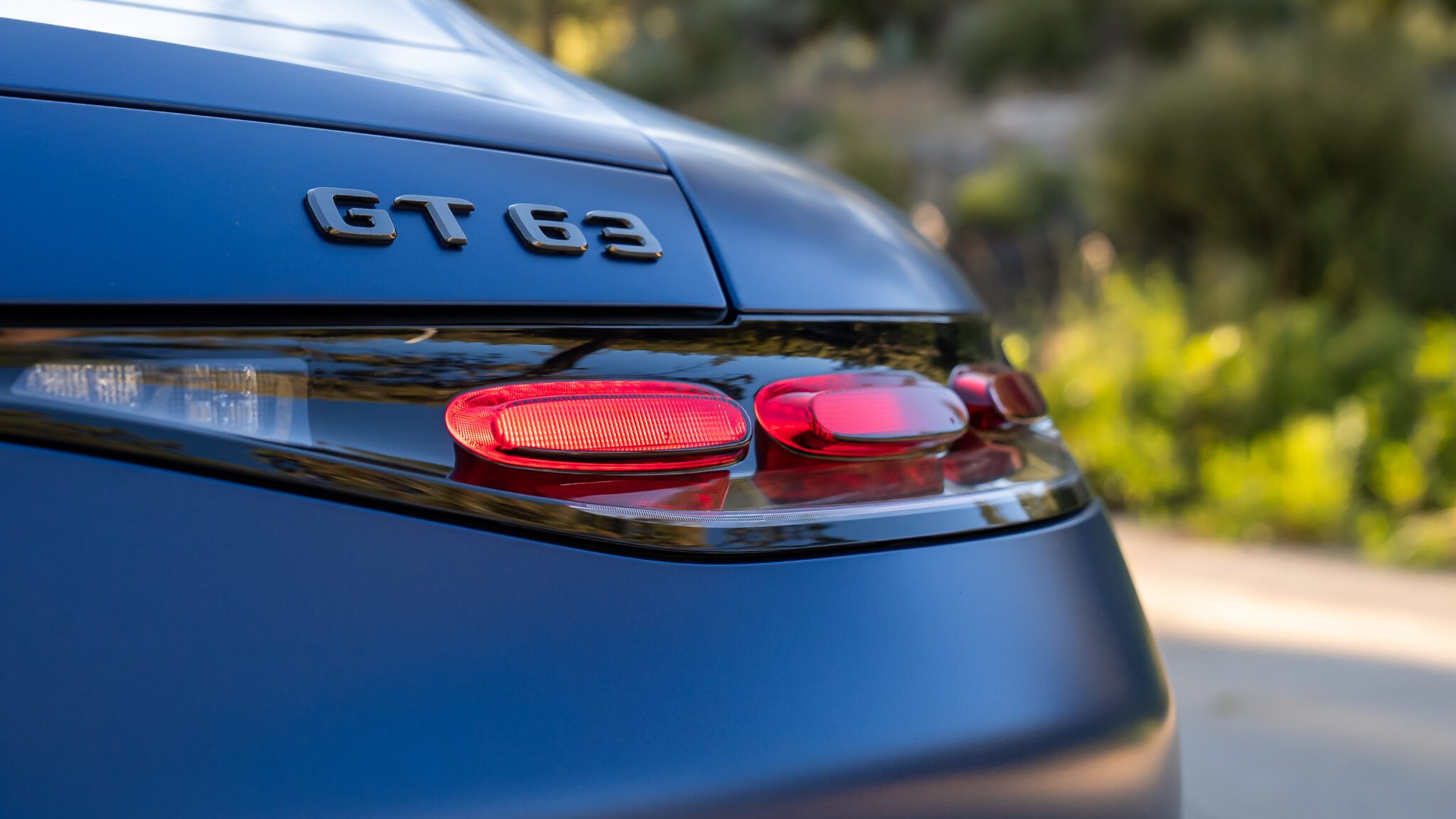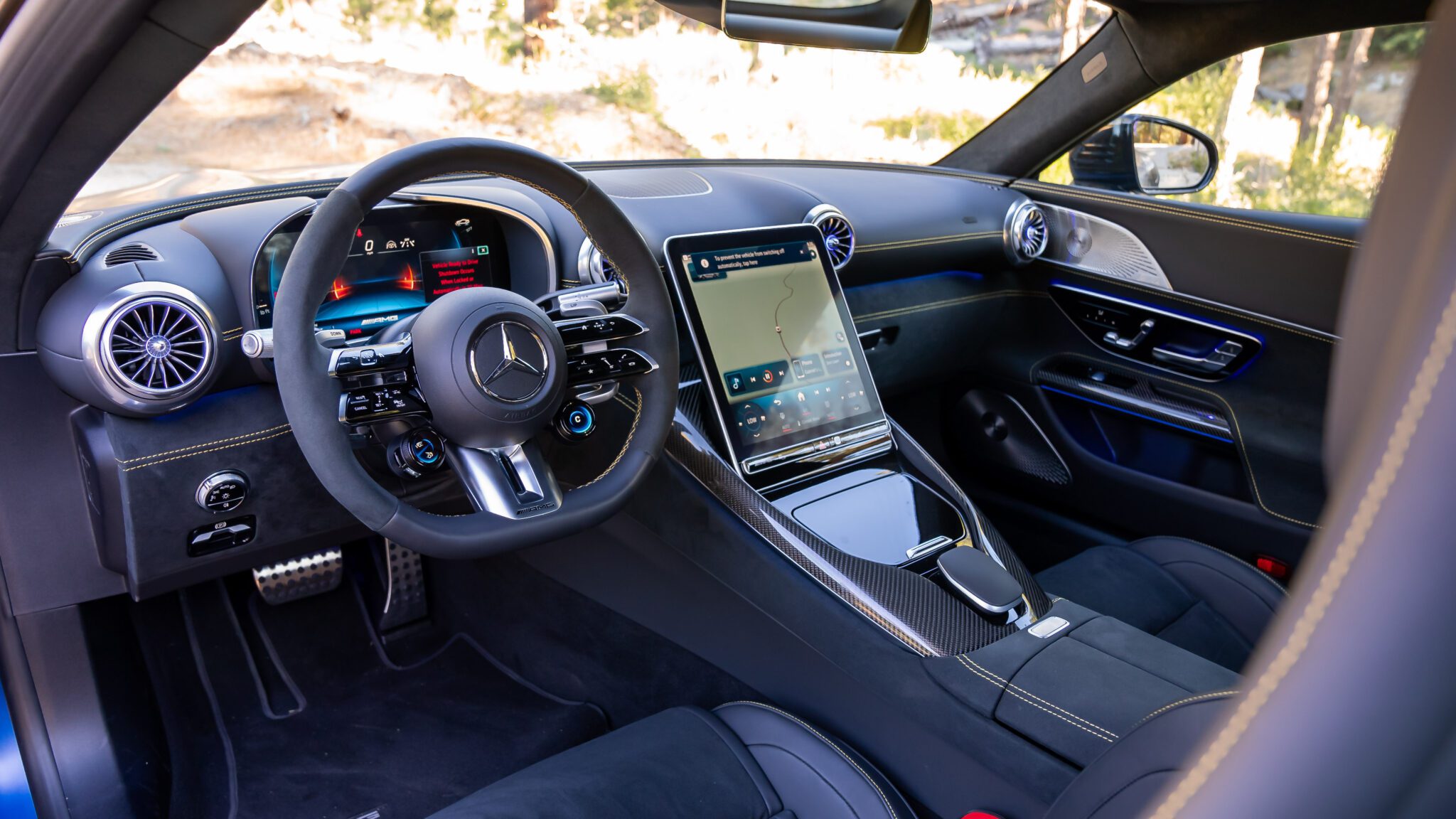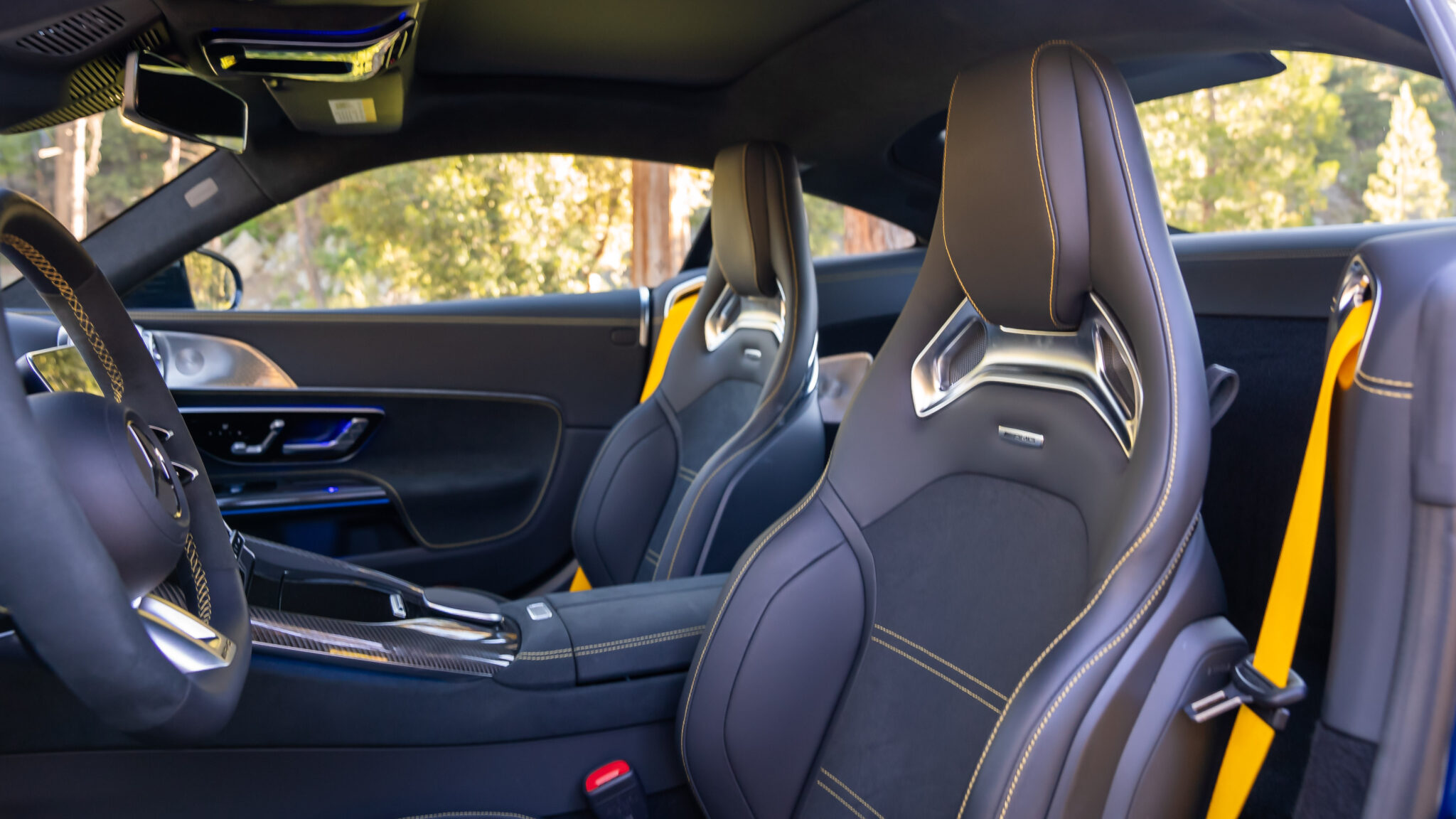Whenever we link up with a friend we haven’t seen in a while, there’s sometimes a split-second of surprise. The image of them in our heads, how they style their hair, dress, and mannerisms, suddenly clashes as we look at the updated version of the person we’ve come to know. And while our brains quickly settle as we catch up, it’s nonetheless fascinating how even subtle changes can jump out with a tremendous ability to shock.
Although not a friend nor a person, that’s precisely how I felt when a Staling Blue Magno-finished 2024 Mercedes-AMG GT63 pulled up to my house a few weeks ago. Everything I can see, its long hood, sleek sloping roofline, and oversized quad exhaust tips, tell me I’m looking at AMG’s Porsche 911 fighter, but it doesn’t feel that way. Something’s slightly off. The last GT I drove years ago was a long-slung, rear-drive, agile sports car adorned with touches of Mercedes elegance. At first glance, this seemed like an entirely different kind of machine.
It’s longer, taller, and wider than the car it replaces. In practically every dimension, the new GT is substantially upsized. Peek under its hood, and you won’t find any obvious reasons why. After all, it’s powered by an updated version of the same twin-turbocharged 4.0-liter V8 as its predecessor, now generating 577 horses, matching the outgoing GT R. Instead, the culprit lives beneath the skin as the 63, along with its less powerful 55 and 43 twins, shares a platform with the latest SL.
This isn’t inherently a bad thing, though. AMG designed and built the latest Sport-Leicht entirely in-house. No standard production Benz runs alongside it. It’s a proper Affalterbach thoroughbred. However, merging a convertible cruiser with a sports car requires a fair bit of compromise. It’s why, in part, the new GT now comes standard with a 2+2 seating arrangement. This tester, however, replaces its second row with a flat shelf.

The alarm bells begin to sound as we dive deeper into the details. Although platform sharing doesn’t always result in substantial weight gains, in this case, it does. The 2024 Mercedes-AMG GT 63 is a full 783 pounds heavier than the car it replaces, with a curb weight of 4,343 lb. For context, its closest competitor, the 911 Carrera 4 GTS, weighs in at 3,536 lb. Even the Turbo positioned above it sits at 3,649 lb.
Are these mass gains as impactful as they seem on paper? The GT’s performance stats certainly don’t indicate so. Offered only with all-wheel drive in 63 and 55 forms, the GT is quicker than its predecessor, sprinting to 60 mph in 3.1 seconds and continuing onto an electronically limited 196 mph top speed. It may be larger and heavier, but AMG hasn’t broken the unwritten rule set by stat-focused enthusiasts that a new performance car must be more powerful and quicker than it replaces. On paper, gains are always welcomed, but given that AMG still positions the GT as a sports car, those improvements have to amount to a more thrilling driving experience.

On a quiet Saturday morning, I pointed the GT’s nose towards the canyons north of Los Angeles, with its configurable drive settings, suspension, and exhaust set to full-attack mode. In the days leading up to my canyon run, the Mercedes-AMG GT 63 had proven itself a versatile grand tourer with versatile and compliant suspension and a well-isolated cabin. Nothing should get in the way of becoming your daily driver. Not even this tester’s firm $2,500 AMG Performance Seats spoil the ride. Add the benefits of a sizable 23.8 cubic feet trunk made possible by its rear hatch, and the GT is an excellent one-car solution.

The GT makes a great first impression at speed on the twisty road. Thanks to all-wheel traction, a quick-shifting nine-speed automatic, and a full 590 pound-feet of torque, the hefty 63 picks up speed effortlessly. The character of its twin-turbo V8 is surprisingly familiar, just more responsive than in previous iterations. Despite lacking any form of electrification, the GT minimizes turbo lag, riding an unrelenting wave of torque up to 5,000 rpm, where it trails off slightly as its engine spins up past seven grand. Short-shifting is vital to getting the most out of it. Not a problem when a tug of the right paddle serves up the next gear almost instantly.

Dive into a bend, and the GT 63 has more tricks up its sleeve. Like everything in its class, it rides on adaptive shocks, adjustable through pre-set drive modes or a configurable individual setting. However, it complements them with a hydraulic anti-roll system that skirts the need for traditional bars. It’s an active system that can dial out body roll in real time. Coupled with an active aero system with an adjustable splitter and a deployable rear wing, the GT remains nicely stable at high speed and in the bends while successfully masking most of its heft.
That is, until you encounter a particularly tight section of road. In most settings, the GT’s $4,000 set of gorgeous 21-inch split-spoke gold wheels wrapped in 295/35 and 305/35 section Michelin Pilot Sport S 5 rubber offer tremendous grip. However, as you tackle a tight set of switchbacks, the 63’s weight comes to the forefront. Connect a few fast corners, and you’ll feel its mass begin to hold you back as it hesitates to turn in sharply. Past a certain pace, the illusion that you’re driving something agile, conjured mostly by its active aero, sticky tires, and clever suspension components, quickly falls apart.

Slow down, drive it less like a sports car and more like a quick grand tourer, and it comes together nicely. The speed of its steering starts aligning well with the front end’s capabilities, leading to a sense of directness. Although powerful enough to consistently slow this hefty two-door on a back road, its standard composite brakes seem mainly calibrated for easy modulation on the street. As such, they’re much happier at this chiller pace.
There’s an argument to be made that this grand-touring persona is one the GT, especially given its name, should’ve embraced from the beginning. If you look at the road cars produced by Mercedes and AMG over the past few decades, you’ll find only a handful of track-capable sports cars. What you will see plenty of, however, are large muscular luxury cars with great big fire-breathing engines, precisely what the Mercedes-AMG GT 63 is.

Although much has been said about its new platform and its substantial weight gains, especially in this review, the new GT manages to make an important point: chasing the 911 isn’t always the right move for a brand looking to establish a lasting nameplate. While its predecessor made a considerable splash in the industry, later spawning a convertible variant, a track day special, and a track-er day special, it didn’t manage to draw enough buyers away from its key rival. Last year alone, Porsche sold more 911s than Mercedes did GTs in the previous four years combined.
The arrival of this latest generation does create, however, an opportunity for the GT to redefine itself, leaning on what’s made us love AMG, both new and old. It starts with a clear advantage; at least stylistically, it’s a more interesting purchase than the ubiquitous Porsche. Given that it wears one of the most successful designs out of Affalterbach in recent memory, the GT drips with a level of swagger the 911 can’t match. Given its relative rarity in comparison, seeing one in the wild results in an immediate neck snap.

Sat low to the ground with widened wheel arches and its softly sloping roofline, the GT’s styling is substantially more evocative than the SL’s. It has practically perfect proportions thanks to enlarged headlights, a widened grille, and a vast movable rear wing. And despite its platform sharing, it still manages to capture the magic of the long-hooded style with its passenger compartment positioned as far back as possible.

Its good looks carry into its cabin, where its upsized passenger compartment feels far roomier than its predecessor’s, with improved visibility and front-row space. Its material choices and overall fit and finish have also substantially improved, although you’ll have to deal with the same screen-heavy layout as seen in the SL. It’d be fine if it were easy to navigate, but swiping through various menus while driving is unnecessarily distracting. Opt instead to control it through your wheel-mounted swipe controls, and you’ll encounter an equally frustrating experience, given that they rarely work as intended.

There’s also the matter of its price. The 2024 Mercedes-AMG GT 63 starts at $178,750, including fees, marking a significant increase over its predecessor. This stunning matte blue tester carries an as-tested price of $209,310.
After a week on the road, it’s become apparent whether you’ll feel that the new GT is a successful second-generation product comes down to the perspective with which you approach it. Expect it to be mainly a Porsche 911 fighter like its predecessor, and you’ll find a car that delivers a dulled driving experience. It may be quicker to 60 and still tremendously fast in a straight line, but it’s not particularly agile in the bends thanks, in part, to its 783-lb weight gains despite the efforts of its active aero, hydraulic anti-roll system, and adaptive shocks.

There is an initial shock once you see and feel how much the GT has changed, one you’ll need some time to get used to. However, it’ll quickly become apparent how good of a comfortable, spacious, practical, and fast long-distance machine it is. A versatility complemented by its jaw-dropping looks and a ferocious and characterful engine. However, despite how much it has shifted as it enters its second generation, AMG could take it one step further, dropping its sports car branding and embracing the GT’s strengths as a world-class grand tourer.

